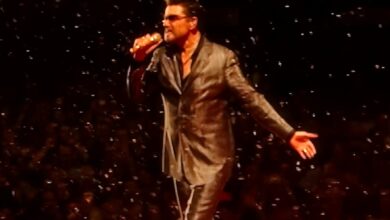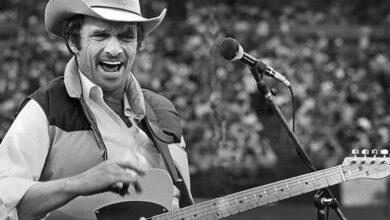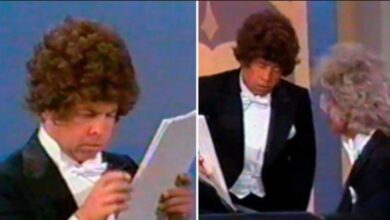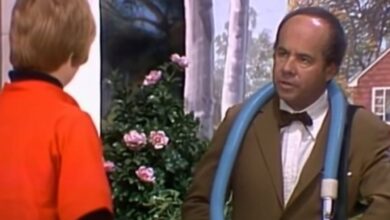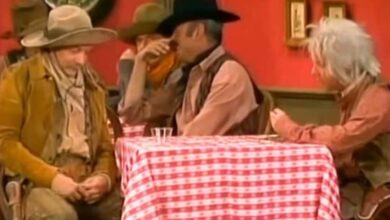KISS Ignited Unfiltered Energy with a Seven-Minute Rendition of “She” on The Midnight Special (1975)
The stage in Burbank looked plain at first glance — a handful of risers, tangled cables, and red recording lights blinking in the haze. But the moment KISS launched into “She,” the air seemed to crack open. Taped on April 1, 1975, at NBC Studios, and aired that summer, the performance wasn’t just television — it was ignition. Paul Stanley’s slashing rhythm, Gene Simmons’ growling bass, Peter Criss pounding out thunder, and Ace Frehley’s silver-lined guitar tone came together like a power surge. They didn’t just play; they detonated, proving that arena energy could be shrunk to fit inside a glowing TV screen without losing a spark.
“She” has always been one of those elusive songs — too bluesy to be pure metal, too heavy to be simple rock, yet somehow entirely KISS. On The Midnight Special, the band reshaped the track into something almost cinematic. The slow burn of the intro acted like a fuse, winding the tension tight before the riffs began to hammer. The show’s cameras stayed close, turning every flick of a pick or crack of a snare into punctuation marks. The intimacy of the broadcast forced the band to focus, transforming every movement into part of the storytelling. It was power wrapped in precision, chaos measured in beats per minute.
Seeing a band famous for fire, blood, and smoke stripped down to four musicians under white-hot lights was a revelation. No explosions, no smoke cannons — just performance. Paul seemed to conduct the band with a flick of his hand; Gene’s attack on the bass was sharp enough to cut glass. Peter’s drums cracked like gunfire but still swung with groove. And Ace — the Spaceman — leaned into his guitar like it was an extension of his pulse, each note bending and shimmering in its own gravity. It was less theater, more truth — four men channeling electricity through raw sound.
This version of “She” lives and breathes differently from every other. It has weight and grit, but it’s never cluttered. There’s space between every beat, an invisible air that lets the groove expand instead of collapsing into distortion. On cheap ’70s TV speakers, that clarity mattered. The edges of the song stayed sharp, the swagger unblurred. What you heard wasn’t just a performance — it was compression and combustion coexisting, the streets of New York funneled through a television tube and straight into America’s living rooms.
The taping itself became legend over time. KISS filmed four songs that day — “Deuce,” “She,” “C’mon and Love Me,” and “Black Diamond.” Choosing to air “She” early was a master move. It wasn’t all flash; it had soul. It showed a band that could smolder instead of just explode, groove instead of grandstand. Television finally caught a glimpse of KISS’s depth — not just spectacle, but chemistry, power, and timing honed from smoky clubs to packed arenas. It was the moment they shifted from curiosity to inevitability.
When “She” premiered on July 11, 1975, alongside “Deuce,” it was like a one-two punch. “Black Diamond” would follow later, stretching the band’s presence across weeks of airtime. That staggered rollout built anticipation, giving the illusion that KISS were already too big to contain within a single episode. Viewers waited for the next chapter, and by the time it aired, KISS had become less of a band and more of a television phenomenon — the embodiment of rock’s new mythology.
The performance itself was predatory and hypnotic. Paul chopped through the rhythm like an axe through timber, Gene stalked the low end like a predator circling prey, and Peter’s toms gave the verses their heartbeat. Then came Ace’s solo — bright, wild, defiant — stretching the song into something cosmic. His phrasing wasn’t just technical; it was emotional. He played like someone transmitting through static, sending a message no one else could decode but everyone could feel.
That’s why this version of “She” keeps resurfacing. It’s longer, looser, and more alive than any other. Seven minutes of pure tension and release, every second earned. You can hear them locking into a trance, riff after riff passed like sparks between hands. The groove tightens, the energy swells, the focus never wavers. What could’ve been indulgent becomes a masterclass in control — proof that a rock band could stretch time and still keep you holding your breath.
The studio audience, polite but restrained, becomes part of the mystique. You don’t hear them much — you sense them. KISS played as if the walls were invisible, as if Burbank had become Madison Square Garden. They performed not for applause but for domination, pushing the boundaries of what TV could contain. The sound, the posture, the attitude — it all screamed scale. For a few minutes, a TV stage became a stadium.
Midway through, the spotlight finds Ace, and time seems to slow. His solo doesn’t boast speed; it breathes emotion. Each bend arcs like neon over asphalt, every sustain carrying its own gravity. The tone — gleaming yet gritty — defined a generation of kids dreaming of guitars. That night, he wasn’t just playing; he was painting sound, glowing in the halo of his own creation. The Spaceman lived up to his name, orbiting around melody and landing squarely on magic.
Decades later, the performance holds a new weight. When the world lost Ace Frehley in October 2025, the news sent shockwaves across the rock universe. Watching this clip now, knowing he’s gone, changes everything. The solo that once felt like a launch now feels like farewell — his final signal sent from a galaxy of distortion and light. Every note carries memory, every echo a reminder that heroes burn brightest before they fade.
The tributes that poured in after his passing only echoed what this footage had always shown: Ace wasn’t just part of KISS — he was its spark. The grin, the stance, the effortless lift-off every time he hit a note — that was his signature. On *The Midnight Special*, you can see the myth forming in real time, the Spaceman rising from the smoke of his own creation, destined to shine far beyond the frame.
What makes this performance endure is its contradictions. It’s fierce yet vulnerable, theatrical yet honest, bound to television yet eternally alive. “She” is the vessel, but what you witness is pure current — four men generating something bigger than themselves and sending it through the wires into eternity. Back in 1975, it was revolution. In 2025, it’s resurrection — a time capsule humming with the sound of immortality and a guitarist whose tone still cuts through the static of time.
Freeze the frame at the end: Ace leaning back, the lights blooming around him, his final note stretching into eternity. Peter’s final crash lands like thunder, Gene growls one last riff, Paul slashes the air with a single stroke — and then silence. That’s the image that stays burned into memory. Television didn’t domesticate them that night; it unleashed them. And Ace, ever the Spaceman, was already halfway to the stars.
